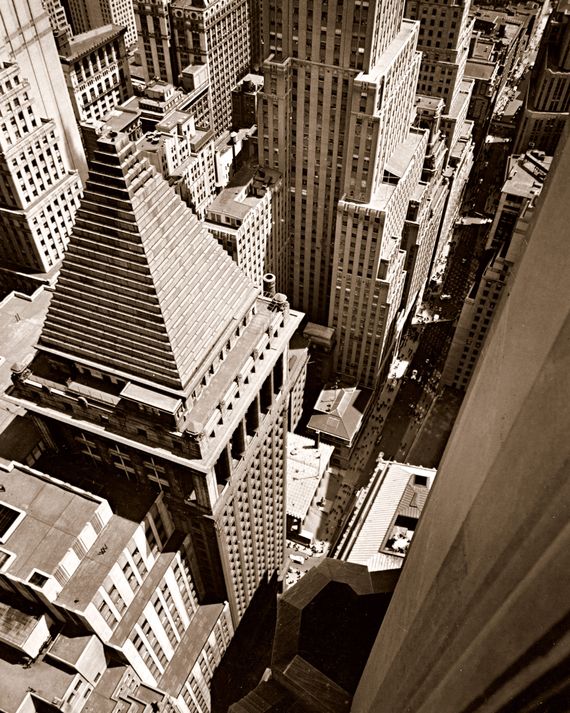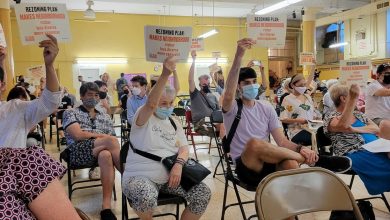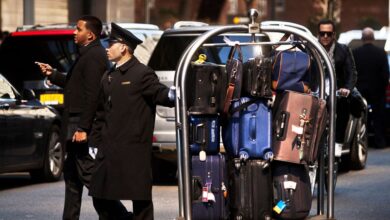How the Office Made New York City What It Is Today


Looking down on Wall Street, 1938.
Photo: Berenice Abbott/Smith Collection/Gado/Getty Images
Morning rush, 1896. The Third Avenue elevated train clatters into 23rd Street. A young woman trudges down the iron stairs, plucks her skirts just clear of the sidewalk, and joins the torrent of men in dark suits and women in white blouses converging on Madison Square. It’s taken a lot of convincing to get to this first day of work. Her parents know the neighborhood as a den of the disreputable rich, where bright new mansions are interspersed with the concert saloons that the Reverend Parkhurst is so bent on expunging. A few blocks up is Madison Square Garden, with its boxers and opera singers. (“Tonight and Friday evening will be Wagner nights,” the Times warned. “Every night there will be beer.”) And an office is no place for a girl either. Her father should know, having spent decades hunched over an oak desk in a shipping company’s lightless front room along with a dozen other sallow men.
But everything is different now. A few years ago, the Metropolitan Life Insurance Company built itself an 11-story palazzo at the corner of Madison Avenue and East 23rd Street, and it’s practically a billboard for respectability. Men — clerks, accountants, executives, cashiers — enter through one portal. An even larger group of typists, stenographers, and switchboard operators flows through another: “Metropolitan Belles,” the company calls its young unmarried female employees, with their brisk step and pinned-up hair. There’s no risk of their bumping into a man, the young woman has assured her mother, because elevators, hallways, and lunchrooms are segregated with monastic strictness. She won’t mention the roof terrace, where the sexes mingle during breaks.
New York City and the office transformed each other at the end of the 19th century so quickly and profoundly that it makes the digital age seem sluggish. Until then, New York’s world of steel-pen-pushers still resembled the London law office in Dickens’s 1853 novel Bleak House, where the narrator looks around “at the shabby, dusty tables, and at the piles of writings, and at a bookcase full of the most inexpressive-looking books that ever had anything to say for themselves.” Clerks, those creatures of the gloom who earned little, each day affixing new white collars to graying shirts, mystified most Americans, who had a hard time recognizing what they did as work. “What wretched, spindling, ‘forked radishes’ would they be … if suddenly they could all be stript naked!” Walt Whitman wrote. A bodybuilding manual from 1866 promised that scrawny clerks and pudgy merchants didn’t have to stay that way: “Note in the crowded thoroughfare of Broadway now and then an occasional passer-by, with well-knit and shapely form, firm and elastic step, broad-chested and full-blooded” — an early gym rat.
Then came a cascade of technological innovations and social changes that swept away all the mustiness and pretensions. Corporations expanded their reach across the continent and the oceans, creating vast markets and equally vast quantities of paperwork. The flow of numbers, contracts, and correspondence demanded a new workforce, which in turn required big spaces and reliable lighting. Steel-frame buildings swelled along with capitalism’s ambitions, and elevators sped workers to their desks, now illuminated by vast windows and, eventually, fluorescent bulbs. Before too long, air-conditioning systems kept the white-collar armies comfortable and alert in every season, and office work was broken down into tiny tasks that could be executed at high speed, day in, day out. Productivity was king. By 1914, 20,000 people were trooping in and out of Met Life every day, popping 5,000 internal messages through its network of pneumatic tubes. It was an information factory on a colossal scale.
In the space of a couple of decades, the word office, which had once referred to an administrator’s responsibilities, then to a dedicated room in a warehouse, home, or factory, came to describe a building, then a district — even a whole culture. “The history of architecture offers few more striking contrasts than that between a palatial structure like the Metropolitan [Life] Building and the little 4- or 5-story buildings in which the merchants of a generation or less since transacted their business,” Barr Ferree, the author of an 1896 primer, The Modern Office Building, reported. Met Life grew so fast that it gobbled up the entire block from 23rd to 24th Street between Madison and Park Avenues and in 1909 capped the complex with a New York knockoff of the bell tower that had recently collapsed in Venice’s Piazza San Marco. The campanile turned the insurance outfit into a real-estate powerhouse that rented space to smaller businesses; it also, an executive chortled, was “an advertisement that didn’t stand the company a cent because the tenants footed the bill.” A scrappy, improvised city of wood and brick was rapidly turning into a stone-and-steel metropolis that was heavily invested in the future. These changes transformed urbanites’ relationship to space and time. New York’s street grid had unfurled from the downtown tangle of footpaths up along the length of Manhattan, and by the start of the 20th century, the checkerboard had been extruded into three dimensions. Streetcars clanged along straight avenues, the elevated thundered above, and the subway ran below, paralleled by conduits for steam, electricity, and telephone. When the passenger elevator birthed the high-rise office building, the rectilinear matrix flowed up toward the clouds.
Vertical transportation soon came to organize the architecture of skyscrapers and, consequently, the lives of those working in them. Upper stories, far above the din and dung of the street, became the executives’ domain. The dense new business districts sucked in so many workers every morning and spit them out again in the evening that they couldn’t all live nearby. Instead, swelling armies traveled farther and faster — underground, over bridges, and straight up into the sky. The elevator helped create the mass commute.
There was something at once vital and infernal about that all-consuming Cartesian creation. The modern metropolis pumped out money, softened hardships, and left room for leisure. But office life also forced millions to snap to a universal grid, a high-tech echo of the clerk’s dry servitude. Workers sat at identical desks near modular windows, beneath rectangular ceiling tiles and geometric light fixtures, repeating codified tasks on standardized equipment. That mechanization was made more expeditious by a new workforce of women, who accepted lower pay, constant supervision, and an endless supply of drudgery. Typewriters smoothed their way. Men had no prior hold on the newfangled gizmos, and so were willing to let women take them over. Soon, “women were claimed to be more manually dexterous and tolerant of routine than men and therefore more suited, by virtue of their very natures, to operate typewriters,” writes Margery Davies in Woman’s Place Is at the Typewriter: Office Work and Office Workers, 1870–1930.
The early-20th-century business district was erected helter-skelter, one tower at a time. In the next generation, the Rockefeller family wanted a cohesive corporate city — massive enough to reshape the skyline, shift the economic center of gravity uptown, contain a cultural mecca or two (plus shopping, restaurants, and public space), merge landmark and logo, and still have plenty of square footage left to rent out. The critic Lewis Mumford initially reacted with spasms of contempt. The project, he wrote in 1933, amounted to “a series of bad guesses, blind stabs, and grandiose inanities.” The first decade or so bore him out — it took a Depression, a world war, and a postwar boom before Rockefeller Center made big money, and longer than that to earn New Yorkers’ abiding love.
Having achieved quasi-militarized heights of orderliness and predictability, corporate America began to reconceive the office as a creative zone. By the 1950s, the men who ran companies from behind closed doors had started to shape a new kind of workplace, one where the rank and file would want to, not just have to, spend their days. Office work permeated the mainstream. If average Americans had once seen themselves mostly as farmers, soldiers, shopkeepers, and laborers, now they were becoming a nation of secretaries and middle managers. “At the end of World War II, roughly half of New York’s wage workers made, moved, or maintained physical objects for a living, everything from corsets to skyscrapers to aircraft carriers,” writes Joshua Freeman in Working Class New York. But that was changing rapidly. As manufacturing moved away, the children of factory workers could either move with it or change the color of their collars. That massive economic shift produced a chorus line of modernist slabs and tides of commuters sloshing into Manhattan every morning and back to the suburbs at night. Advertising agencies, magazines, and television stations increasingly demanded staff who could think. Industrial juggernauts like GE and Philip Morris saw themselves as molding the nation’s culture from their New York headquarters. Assembly lines of paper processors were no longer enough.
Seeking a spirit of community, some companies followed their executives to the suburbs, building horizontal equivalents of midtown skyscrapers ensconced in woods, meadows, and moats of parking. In their office parks, colleagues could focus on their tasks in serenity, untroubled by subway crowds or lunch-hour shopping. Not incidentally, placing offices in the vicinity of all-white (and mostly Protestant) suburbs would ensure that companies remained similarly segregated.
The urge to fashion a hermetic, horizontal world of comfort and concentration, a kind of capitalist monastery, runs from early corporate campuses of the 1940s and ’50s to the low-rise tech landscape of Silicon Valley. It was the heavy hitters of mid-century, not the start-ups of 2000, that discovered that if you want employees to feel at home where they work, you need to make the workplace feel like an idealized version of their homes. You can see that philosophy taking hold in the deluxe headquarters of Connecticut General Life Insurance Company (now Cigna) in the Hartford suburb of Bloomfield. Gordon Bunshaft, chief architect of Skidmore, Owings & Merrill, designed the low, sleekly rectilinear building, which opened in 1957, and Florence Knoll conjured interiors that elided the difference between work and life. Sales reps could spend their days amid high-modernist glamour they might have chosen for their own living rooms, if only they had the money.
Early-20th-century managers saw the office as a place where nose met grindstone; their postwar counterparts aimed to engineer contentment, competitiveness, and collaboration. Another half-century after that, the tech world elevated the “casual collision” into an organizing principle. In 2013, Yahoo rescinded all work-from-home permissions, arguing that “some of the best decisions and insights come from hallway and cafeteria discussions.” The concept was hardly new. At Bell Labs in Holmdel, New Jersey, designed by Eero Saarinen and completed in 1966, researchers’ offices opened onto breathtakingly long corridors around an atrium that were explicitly intended to foster interaction and chat. Even the railings were designed to support extended conversation, wide enough to rest an elbow on and punctuated at intervals by ashtrays.
Decades later, Google was celebrated for pioneering the workplace as the only place you ever really needed to be. By 2012, its newly revamped offices in Chelsea included a primary-colored romper room (with slide), a fake subway platform, a fake rooftop water tank, a fake Broadway-theater lounge, and even a fake work-from-home walk-up. The reproduction tenement featured a “bathtub” in the “kitchen,” a “view” onto a “fire escape,” and even “utensils” on the “stove” — all of it looking less like an actual apartment than a cheap sitcom set: a simulacrum of a simulacrum.
Virtually every force that the birth of the office unleashed more than a century ago continued to operate in our own time — until the pandemic hit. Buildings grew ever more massive. New technologies offered the promise of greater productivity. All-inclusive environments encouraged workers to linger for another hour or five before going home. And planners kept trying to harness the volatile energy of the corporate world to reengineer the city, with dramatic results and uneven success. In the late 1960s, the construction of the World Trade Center was supposed to revitalize the deindustrialized shoreline of lower Manhattan — a strategy that was finally paying off when it was destroyed in 2001. Starting in the early 1990s, sordid and neglected Times Square was rebuilt to attract law firms and media companies as well as tourists. The Bloomberg administration rezoned Downtown Brooklyn, hoping to turn it into a new business district but seeding a forest of apartment towers instead. The whole satellite city at Hudson Yards emerged from a decades-long desire to provide the sort or airy, advanced headquarters that the wealthiest companies demanded. Tech start-ups gravitated to once-derelict waterfront industrial areas, nudging developers to rehabilitate hulks like the Domino Sugar refinery in Williamsburg or put up new buildings at the Brooklyn Navy Yard. Now we’ve hit another inflection point in the story of office space: New York’s immense infrastructure of white-collar work lies mostly vacant, as both employees and employers weigh the trade-offs of Zoom meetings, business travel, cubicles, and conference rooms. Perhaps we’ll all just rewind to 2019, except for a few extra feet of space between desk chairs and sanitizer stations positioned like sentries. But for now, at least, New York’s business world resembles that of the 18th century. Back then, the Tontine Coffee House, on the corner of Wall and Pearl Streets, was the center of mercantile life. At times, brokers met nearby in the shade of a buttonwood tree, the only office they needed when the weather was mild.
See All




